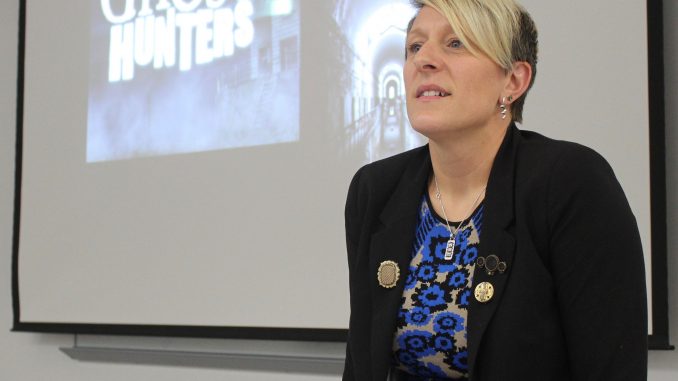
When Sarah Iepson visited the Metropolitan Museum of Art in New York while researching her dissertation on the portrayal of children in 19th-century art, she was struck by Ambrose Andrews’ painting, “The Children of Nathan Starr.”
The work shows five siblings playing a game with rackets, but the youngest sibling, a little boy in a dress, is deceased. His racket lays on the floor, unused.
“I was like, ‘Oh, that’s weird,’” said Iepson, a 2013 art history Ph.D. alumna and head of the Community College of Philadelphia’s art department. “That got me down the path of posthumous imagery, and it snowballed into a dissertation on that.”
Just in time for Halloween, Iepson gave a talk at the Tyler School of Art on Friday about the role of spiritualism — an ideology that claims humans have spirits within them that become evolved entities upon death — in artwork. She highlighted spirit photography, the practice in which a photographer attempts to capture ghosts or other spiritual entities on camera. Iepson’s interest in spirit photography developed after seeing Andrews’ painting.
In her talk, Iepson said death was a common topic in the 19th century because of short life expectancies. Death was handled differently than it is today, with the deceased person displayed in the home so others could pay their respects before the family buried the body. Similarly, Iepson said mourning and grief were communicated differently than they are today.
In the 1800s, specific clothing was worn by mourners every day to indicate where they were in their grieving process. Black clothing indicated being in the early stages of grief, and a lighter shade of black or gray would be worn further into mourning.
These clothes helped others understand how to interact with those in mourning, a technique Iepson said she finds helpful.
“I often think that we don’t know what to do anymore with grief and with death and dying,” Iepson said during her presentation. “People don’t know what to say to other people.”
She also discussed the rise in popularity of spiritualism.
Iepson said spiritualists believe spirits want to communicate with people on Earth because they have messages from God. The concept of spiritualism developed after the Civil War because of the number of people who lost their loved ones in battle without a chance to say goodbye. More than 600,000 people died in the Civil War, according to the BBC.
At this time, William H. Mumler, a spirit photographer, began offering his services at the expensive price of $10 for 12 pictures. He said the photos he took captured the spirits of his customers’ deceased loved ones. Mumler took photos of his clients and made it look like their loved one was in the background as a translucent spirit.
Today, it is thought that Mumler’s work is simply the result of long exposure photography techniques, Iepson said. He destroyed all his film negatives before his death, so no one could further investigate his work.
Adjunct art history instructor Ariel Pearce said she has mixed feelings about Mumler’s work.
“People like Mumler saw this need for these desperate people who just wanted to connect somehow with the deceased,” Pearce said. “They were willing to pretty much believe anything. So I look at it like he’s fulfilling a need, but if you look at it on the other hand, he’s really quite a horrible person.”
Pearce added that she liked how Iepson’s talk highlighted the differences between mourning in the 19th century and today. She said although mourning is practiced differently in different cultures, there’s a common thread of wanting to believe in the afterlife.
“It’s so hard for people to deal with death in their lives,” Pearce said. “There’s a hope of something better for other people and for ourselves. I think that all those funerary practices and mourning rituals, they’re for the living. They’re not really for the deceased.”
Sidney Moore, a senior illustration major at Moore College of Art & Design, said she went to the event because she’s interested in how death is handled by society. She added that she thinks spirit photography is interesting.
“It combines a lot of my interests like art, death and spiritualism,” Moore said. “Death is the ultimate equalizer.”
Iepson said while she doesn’t know anybody who does spirit photography professionally, people dedicated to the craft are still out there.
“There are ghost hunters, so I always think that’s interesting,” Iepson said. “People are still doing it. People are still trying to capture something, energy or entities or spirits.”



Be the first to comment